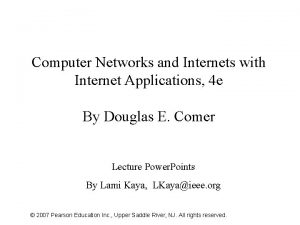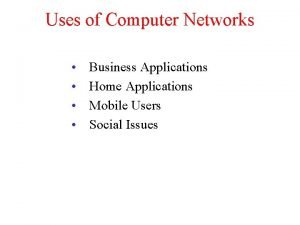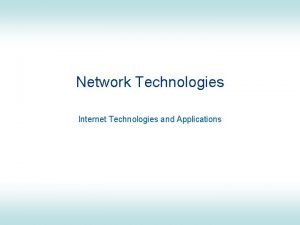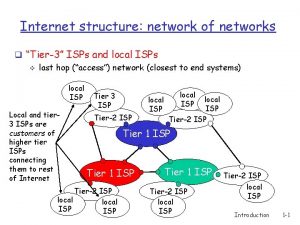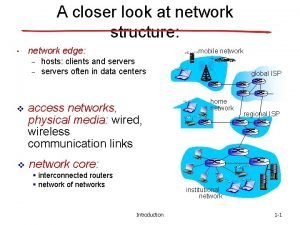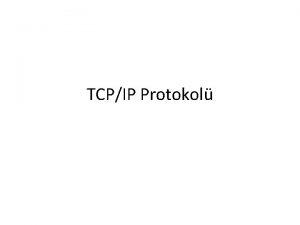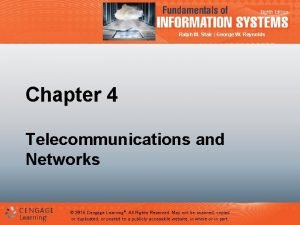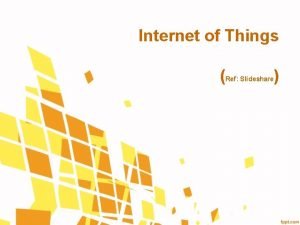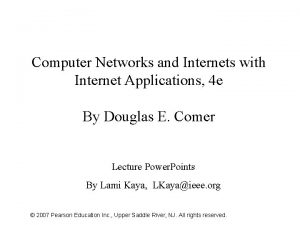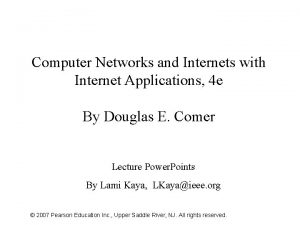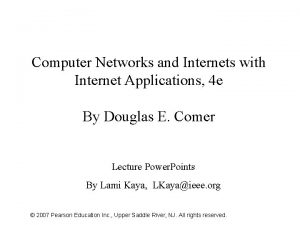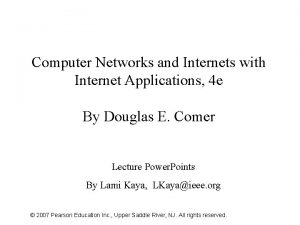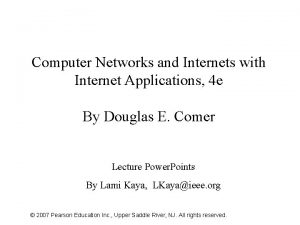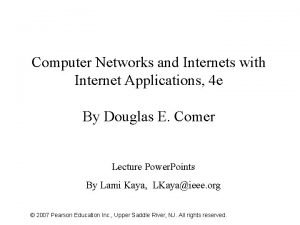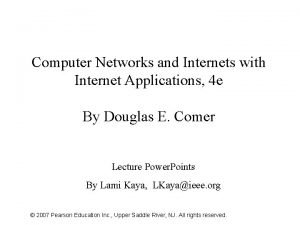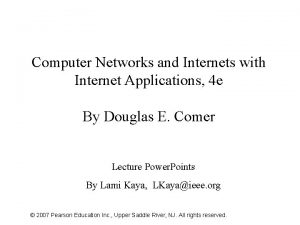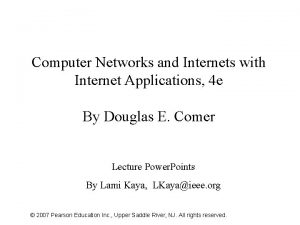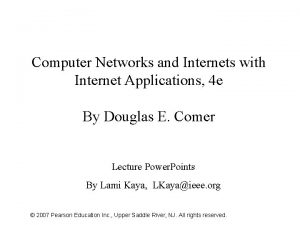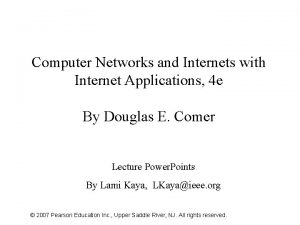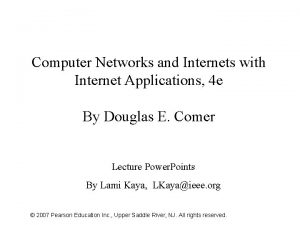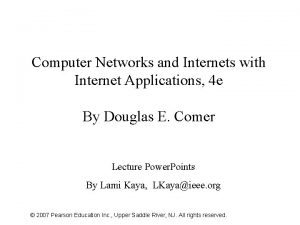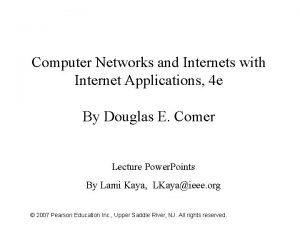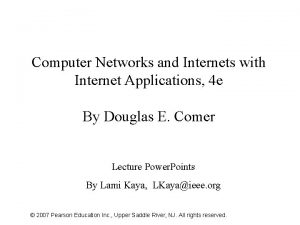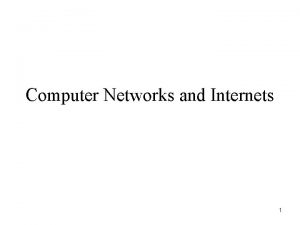Computer Networks and Internets with Internet Applications 4


























- Slides: 26

Computer Networks and Internets with Internet Applications, 4 e By Douglas E. Comer © 2007 Pearson Education Inc. , Upper Saddle River, NJ. All rights reserved.

Chapter 1 Introduction © 2007 Pearson Education Inc. , Upper Saddle River, NJ. All rights reserved.

1. 1 Growth Of Computer Networking (1) • NW is used in everywhere such as business, billing, advertising, federal, state and local government offices. • Computer networks (NW) have been growing explosively and its impact include: – More and more individual and business use networks to exchange data – Network industry has emerged to develop NW technologies, products, and services – Network has produced a demand in all industries for network professionals to plan, acquire, install, operate, and manage the hardware (HW) and software (SW) systems related to networks © 2007 Pearson Education Inc. , Upper Saddle River, NJ. All rights reserved.

1. 2 Complexity In Network Systems (1) • Computer NW is a complex subject: – Many technologies exist, and each has features that distinguish it from the others – Multiple organizations have created network standards independently, which are not all compatible – Many companies have created commercial network products and services that use the technologies in unconventional ways – Finally, network is complex because multiple technologies exist that can be used to interconnect two or more network • As a result, many combinations of NW are possible © 2007 Pearson Education Inc. , Upper Saddle River, NJ. All rights reserved.

1. 2 Complexity In Network Systems (2) • NW can be especially confusing to a beginner – because there is no single underlying theory that explains the relationship among all parts. – Because multiple organizations define NW technologies and standards, multiple terms exist for a given concept – Professionals often use a technical term from one technology when referring to an analogous feature of another – In addition to a large set of terms and acronyms that contains many synonyms © 2007 Pearson Education Inc. , Upper Saddle River, NJ. All rights reserved.

1. 3 Mastering The Complexity • To master the complexity – one must look beyond the details and concentrate on concepts • For example (Ex): – although it is not important to understand the details of wires used to connect computers to a specific NW – it is important to understand the few basic categories of wiring schemes that exist and the advantages of each • Similarly, – although it is not important to learn the details of how a particular communication protocol handles a congested NW – it is important to know what congestion is and why it must be handled © 2007 Pearson Education Inc. , Upper Saddle River, NJ. All rights reserved.

1. 4 Concepts And Terminology • The text focuses on concepts and avoids unnecessary detail – – – explains the purpose of each network technology gives the advantages and disadvantages describes some of the consequences of using the technology uses analogies and illustrations to simplify explanations introduces networking terminology notes popular abbreviations and synonyms that professionals use © 2007 Pearson Education Inc. , Upper Saddle River, NJ. All rights reserved.

1. 5 The Value Of Hands-On Experience • This text provides a conceptual overview of the material that is essential for a beginner: – deep understanding can only result from personal experience • Readers are strongly encouraged to gain as much hands-on experience, Possibilities include: – – building application programs that communicate over a NW configuring network systems observing protocols in action and measuring system performance • The companion lab text, “Hands-On Networking”, contains many suggestions for experiments and projects – Some of the exercises throughout the text refer to “Hands-On Networking” – and recommend specific experiments that will help the reader gain deeper appreciation of the material © 2007 Pearson Education Inc. , Upper Saddle River, NJ. All rights reserved.

Chapter 2 Motivation and Tools © 2007 Pearson Education Inc. , Upper Saddle River, NJ. All rights reserved.

2. 1 Introduction This chapter • discusses the size and rapid growth of the Internet, and • introduces a few basic tools that can be used to explore NW © 2007 Pearson Education Inc. , Upper Saddle River, NJ. All rights reserved.

2. 2 Resource Sharing (1) • Some of the earliest computer network were built to extend existing computing facilities. – NW were devised that allowed multiple computers to access a shared peripheral device such as a printer or a disk • Main motivation for the first network were share largescale computational power • The U. S. Department of Defense (Do. D) – Advanced Research Projects Agency (ARPA) was concerned about the lack of high-powered computers © 2007 Pearson Education Inc. , Upper Saddle River, NJ. All rights reserved.

2. 2 Resource Sharing (2) • Many of the ARPA research projects needed access to the latest equipment – Each research group wanted one of each new computer type • By the latter 1960 s, it became obvious that the ARPA budget could not keep up with demand – As an alternative, ARPA started investigating data NW – The agency decided to give each group one computer – Interconnect the computer with a data NW • The ARPA NW research turned out to be revolutionary © 2007 Pearson Education Inc. , Upper Saddle River, NJ. All rights reserved.

2. 3 Growth Of The Internet • The Internet has grown from the early research prototype – to a global communication system that reaches all countries • Figure 2. 1 illustrates how the Internet has grown – The figure contains a graph of the number of computers attached to the Internet as a function of the years from 1981 -2003 • When plotted on log-scale as in Figure 2. 2 – the growth appears approximately linear • meaning that the Internet has experienced exponential growth over two decades – The Internet has been doubling in size every 9 -12 months © 2007 Pearson Education Inc. , Upper Saddle River, NJ. All rights reserved.

© 2007 Pearson Education Inc. , Upper Saddle River, NJ. All rights reserved. 14

© 2007 Pearson Education Inc. , Upper Saddle River, NJ. All rights reserved. 15

2. 4 Probing The Internet (1) • The program begins by walking through the Domain Name System (DNS), – system that stores names for computers and then uses a program that tests to see whether the computer is currently online • Tools used to probe the Internet are also available to users • One of the simplest probing tools is a program known as ping: – Ex: ping www. netbook. cs. purdue. edu • The ping program sends a message to the specified computer and then waits a short time for a response. – If a response arrives, ping reports to the user that the computer is alive – otherwise, ping reports that the computer is not responding – Ex: www. netbook. cs. purdue. edu is alive • Figure 2. 3 shows an example of ping output with the timing and repetition options turned on © 2007 Pearson Education Inc. , Upper Saddle River, NJ. All rights reserved.

© 2007 Pearson Education Inc. , Upper Saddle River, NJ. All rights reserved. 17

2. 4 Probing The Internet (2) • In Figure 2. 3, ping sends one request each second – and produces one line of output for each response received • The output tells the size of the packet received – the sequence number, and the round-trip time in milliseconds • When the user interrupts the program, – ping produces a summary that specifies the number of packets sent and received – packet loss – and the minimum – mean – and maximum round-trip times © 2007 Pearson Education Inc. , Upper Saddle River, NJ. All rights reserved.

© 2007 Pearson Education Inc. , Upper Saddle River, NJ. All rights reserved. 19

© 2007 Pearson Education Inc. , Upper Saddle River, NJ. All rights reserved. 20

2. 5 Interpreting A Ping Response (1) • When no response is received, ping cannot help determine the reason: – – – – The remote computer could be turned off disconnected from the NW its NW interface could have failed SW running may not respond to ping the local computer could be disconnected from the NW to which the remote computer attaches could have failed failure of an intermediate computer or NW Finally, ping sometimes fails because the NW has become so congested with traffic that delays are unreasonably long • Ping has no way to determine the cause of the problem © 2007 Pearson Education Inc. , Upper Saddle River, NJ. All rights reserved.

2. 5 Interpreting A Ping Response (2) • Another reason why ping may fail to generate a response is less subtle: – some companies configure their site to reject ping packets • The motivation for disabling ping is security: – if a corporation allows ping traffic to enter its site • the site becomes susceptible to a denial-of-service or flooding attack – so many ping packets arrive that the company's NW and computers cannot respond to legitimate requests – To avoid such attacks, • the company merely rejects ping packets before they enter © 2007 Pearson Education Inc. , Upper Saddle River, NJ. All rights reserved.

2. 6 “Real” Internet delays and routes • What do “real” Internet delay & loss look like? • Traceroute program: provides delay measurement from source to intermediate router along end-end Internet path towards destination. For all i: – sends three packets that will reach router i on path towards destination – router i will return packets to sender – sender times interval between transmission and reply. 3 probes © 2007 Pearson Education Inc. , Upper Saddle River, NJ. All rights reserved.

2. 6 “Real” Internet delays and routes traceroute: gaia. cs. umass. edu to www. eurecom. fr Three delay measurements from gaia. cs. umass. edu to cs-gw. cs. umass. edu 1 cs-gw (128. 119. 240. 254) 1 ms 2 border 1 -rt-fa 5 -1 -0. gw. umass. edu (128. 119. 3. 145) 1 ms 2 ms 3 cht-vbns. gw. umass. edu (128. 119. 3. 130) 6 ms 5 ms 4 jn 1 -at 1 -0 -0 -19. wor. vbns. net (204. 147. 132. 129) 16 ms 11 ms 13 ms 5 jn 1 -so 7 -0 -0 -0. wae. vbns. net (204. 147. 136) 21 ms 18 ms 6 abilene-vbns. abilene. ucaid. edu (198. 32. 11. 9) 22 ms 18 ms 22 ms 7 nycm-wash. abilene. ucaid. edu (198. 32. 8. 46) 22 ms trans-oceanic 8 62. 40. 103. 253 (62. 40. 103. 253) 104 ms 109 ms 106 ms link 9 de 2 -1. de. geant. net (62. 40. 96. 129) 109 ms 102 ms 104 ms 10 de. fr 1. fr. geant. net (62. 40. 96. 50) 113 ms 121 ms 114 ms 11 renater-gw. fr 1. fr. geant. net (62. 40. 103. 54) 112 ms 114 ms 112 ms 12 nio-n 2. cssi. renater. fr (193. 51. 206. 13) 111 ms 114 ms 116 ms 13 nice. cssi. renater. fr (195. 220. 98. 102) 123 ms 125 ms 124 ms 14 r 3 t 2 -nice. cssi. renater. fr (195. 220. 98. 110) 126 ms 124 ms 15 eurecom-valbonne. r 3 t 2. ft. net (193. 48. 50. 54) 135 ms 128 ms 133 ms 16 194. 211. 25 (194. 211. 25) 126 ms 128 ms 126 ms 17 * * means no response (probe lost, router not replying) 18 * * * 19 fantasia. eurecom. fr (193. 55. 113. 142) 132 ms 128 ms 136 ms © 2007 Pearson Education Inc. , Upper Saddle River, NJ. All rights reserved.

2. 6 Tracing A Route (1) • Figure shows the output from traceroute with the destination www. eurecom. fr • traceroute provides more information than ping – Each line corresponds to each of intermediate computers – and one corresponds to the final destination itself – traceroute prints the name of the intermediate computer, and gives the minimum, average, and maximum round-trip times • traceroute cannot be used for all destinations – NW administrators may choose to disable it • to prevent outsiders from obtaining detailed information about their architecture © 2007 Pearson Education Inc. , Upper Saddle River, NJ. All rights reserved.

2. 6 Tracing A Route (2) • Figure illustrates another features of traceroute: – a report of packet loss • The line with asterisks indicates two of three probes received no response (i. e. , packets were lost) • In a later test, all probes were received successfully • We can conclude that the loss was a temporary condition – probably caused by congestion on one of the paths between the source and destination © 2007 Pearson Education Inc. , Upper Saddle River, NJ. All rights reserved.
 Computer networks and internets with internet applications
Computer networks and internets with internet applications Computer networks and internets
Computer networks and internets Virtual circuit tables
Virtual circuit tables Compare internets
Compare internets Basestore iptv
Basestore iptv Uses of computer network in business application
Uses of computer network in business application Principles of network applications in computer networks
Principles of network applications in computer networks Business applications of computer networks
Business applications of computer networks Business applications of computer networks
Business applications of computer networks Internet transport protocol in computer networks
Internet transport protocol in computer networks Internet technologies and applications
Internet technologies and applications Internet structure network of networks
Internet structure network of networks Internet structure network of networks
Internet structure network of networks The internet is a combination of networks glued together by
The internet is a combination of networks glued together by Interconnected networks internet
Interconnected networks internet Intserv vs diffserv
Intserv vs diffserv Error detection and correction in computer networks
Error detection and correction in computer networks Byte stuffing example
Byte stuffing example Bit stuffing computer networks
Bit stuffing computer networks What is the reverse request protocol?
What is the reverse request protocol? Analog and digital signals in computer networking
Analog and digital signals in computer networking Web and http in computer networks
Web and http in computer networks Error detection and correction in computer networks
Error detection and correction in computer networks Protocols and standards in computer networks
Protocols and standards in computer networks Crc in computer networks
Crc in computer networks Applications of internet
Applications of internet Introduction to internet slideshare
Introduction to internet slideshare

